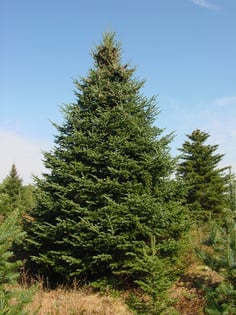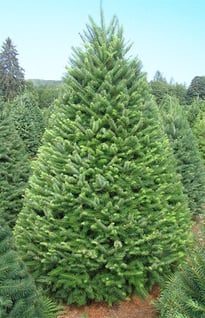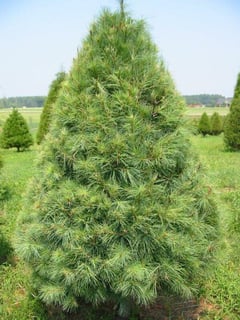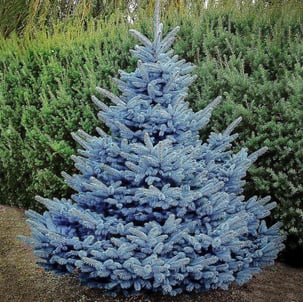The 7 Best Types of Christmas Trees to Deck the Halls
If you thought the Douglas fir was the only kind of Christmas tree on the market, think again! There are several tree species grown across the United States for their Christmastime appeal. The most common tree types include firs, pines, and spruces.
Although all have a relatively similar 'classic Christmas tree' appearance, each type of tree has its own unique strengths and weaknesses. This guide examines the distinctive features of the most popular Christmas tree varieties to help you identify the perfect tree for your home or office.

Balsam Fir: Most Fragrant
The balsam fir is an evergreen tree native to the northeastern United States as well as eastern and central Canada. It's best known for its strong spicy fragrance—a scent often used in seasonal candles and home sprays. The balsam fir also features a cone-like shape with dense, dark green needles that are silver underneath.
Like many firs, the balsam fir features excellent needle retention, lasting up to about four weeks. That said, balsam fir trees have soft, flexible branches that may not be the best choice for heavier ornaments. But if you're looking for a small- to medium-sized tree (up to about seven feet) that can fit in a tight corner, the balsam fir is a great option.
Fraser Fir: Easiest to Transport
The Fraser fir is similar to the balsam fir in conical shape and scent, but the Fraser fir features needles that are slightly lighter in color than that of the balsam fir. Additionally, its yellow-green branches angle slightly upward and are sturdier, making it a better option for heavier ornaments, garland, and holiday décor. The Fraser fir also boasts excellent needle retention if it's kept hydrated after cutting.
Its durability makes the Fraser fir one of the easiest trees to transport. Although it typically grows in the Appalachian Mountains of the Southeastern United States, it's frequently shipped across the U.S. because it generally retains its shape no matter how far it travels.
 Douglas Fir: Most Popular
Douglas Fir: Most Popular
A best-of Christmas trees list wouldn't be complete without the Douglas fir. That's because it's one of the top-selling and most commonly known tree varieties. It makes up nearly half of all Christmas trees grown in the U.S., typically in western North America, extending from central British Columbia south along the Pacific Coast Ranges into central California.
While not a true fir, the Douglas fir has a fuller and wider pyramid shape ranging from medium-sized to extremely large (up to 330 feet). The dark green or blue-green colored needles are soft and feature a sweet scent. That said, the bushy, statement-making fullness does come with a drawback; the Douglas fir will shed its needles quickly if it doesn't get enough water. Its branches also tend to be less sturdy than the balsam and Douglas firs.
Scotch Pine: Best Needle Retention
If you're one to put up your Christmas tree as early as possible, look no further than the Scotch pine. Also known as the Scots pine, the Scotch pine is the most widely distributed pine globally. It grows naturally from Scotland to the Pacific Ocean and above the Arctic Circle in Scandinavia to the Mediterranean.
This Christmas tree variety is best known for its long-term needle retention. Because it doesn't require regular cleanup, the Scotch pine is also one of the lowest-maintenance Christmas tree options. Dark green to blue-green needles grow from stiff branches that are sturdy enough to support decorations of various weights and sizes. But because these trees are often sheared to create a fuller, denser shape, the branches may be close together, posing a challenge when hanging ornaments.
White Pine: Most Natural Look and Feel
The white pine is an excellent option if you want a full Christmas tree that is the focus in and of itself. It features needles that grow in bundles of blue-ish green pointed tips. These needles are long and soft, but the branches aren't very sturdy and won't hold many decorations. That said, the white pine is perfect if you don't want the hassle of shedding; it retains its needles well throughout the holiday season. The white pine is also ideal for people with allergies or sensitive noses, giving off little to no fragrance.
It grows from western Newfoundland, Canada, through the Great Lakes region to southeastern Manitoba and Minnesota, United States, and south along the Appalachian Mountains and upper Piedmont to northernmost Georgia. It also occasionally grows in some of the higher elevations of northeastern Alabama.
White Spruce: Best for Ornaments
On the other hand, if you're looking to completely deck the halls this holiday season, Christmas tree included, look to the white spruce. With blue-green needles that are short and stiff, the white spruce is a viable option for hanging lots of ornaments, lights, and heavier decorations. These trees also have excellent color and a good, natural shape. But don't buy one if you're looking for fragrance. When crushed, these needles actually have an unpleasant aroma, which is why the white spruce is nicknamed "the skunk spruce."
The white spruce grows in the northern temperate and boreal forests in North America. It was originally native from central Alaska all through the east, across southern/central Canada to the Avalon Peninsula in Newfoundland.
Blue Spruce: Most Unique Color
Those looking for something atypical may want to consider the blue spruce, which appears to be dusted in snow with its unique blue and silver hue. Native to the Rocky Mountains near Colorado and Utah, the wintry blue spruce offers dense foliage, good needle retention, and strong branches ideal for decorating. Additionally, it's often sold as a living tree and can be planted outside once the holiday season is over. The blue spruce's primary drawback is its needle sharpness. Although it may not be the best fit for households with small children, it's great for keeping curious pets away.
Take the Hassle Out of the Holidays
Many goods require special shipping conditions. For instance, real plants are generally sensitive to wind and temperature shifts. Because firs and pines like a cold climate and humidity, they also need to be kept watered. These trees are typically delivered as quickly as possible via dry van or temperature-controlled reefer trucks. It may be difficult to arrange shipping for these specialty items, as many carriers seek to avoid complications.
Our specialized shipping services can help you transport your freight safely and on time. Whether you need to move goods via partial dry van, reefer, flatbed, or sleigh, Armstrong's network of 40,000+ carrier partners is ready to help.
Visit our website to see how we can simplify your shipping process while saving you money this holiday season.
About Taylor Borum
Taylor joined Armstrong in 2021, serving as the team's Marketing Coordinator. A native of North Carolina, she moved to Charlotte in 2018 after graduating from Appalachian State University with her bachelor’s in Communication Studies. She's a passionate writer, having curated a diverse range of blog posts, articles, press releases, feature stories, webpage copy, social media posts, and more.



